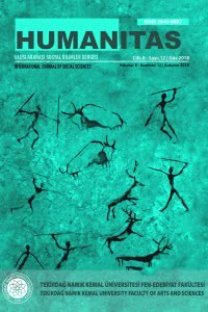Cervantes’in Don Kişot ve Fielding’in Joseph Andrews Adlı Romanlarına Metinlerarası Bir Yaklaşım
Cervantes’in Don Kişot (1605) romanı, birçok sanatçının eseri için ilham kaynağı olmuştur ve bizzat Henry Fielding, Joseph Andrews’un, Don Kişot’un yazarı, Cervantes’in üslubunun etkisi altında kalınarak yazıldığını, romanının kapak sayfasında kabul etmektedir. Buradan hareketle, bu makalede geliştirilen fikirler, Don Kişot ve Joseph Andrews arasındaki tematik ve biçimsel benzerlikleri metinlerarası bir yaklaşımla inceleme çabasıdır. Bu bağlamda, makalede hiciv, parodi, pikaresk roman ve Kişotvari karakter gibi her iki romanda da kullanılan edebi unsurlar karşılaştırmalı olarak incelenmektedir ve dolayısıyla bu çalışma, Joseph Andrews’u Don Kişot aracılığıyla okumanın ve bu romanlar arasında karşılaştırma yapmanın, okuyucuya romanda yeni anlayışlar bulma olasılığını sağlayacağı fikrini öne sürmektedir.
Anahtar Kelimeler:
Metinlerarasılık, Don Kişot, Joseph Andrews, hiciv, parodi
An Intertextual Approach to Cervantes’ Don Quixote and Fielding’s Joseph Andrews
Cervantes’ novel Don Quixote (1605) has been an inspiration for the works of many artists, and Henry Fielding himself on the title page of his novel accepts that Joseph Andrews (1742) was written in imitation of the manner of Cervantes, the author of Don Quixote. Moving from this point, the ideas developed in this paper are an attempt to study the thematic and formal similarities between Don Quixote and Joseph Andrews with an intertextual approach. In this respect, this article explores such literary elements as satire, parody, picaresque novel, and the Quixotic character employed both in Don Quixote and Joseph Andrews comparatively and this study, hence, argues that reading Joseph Andrews through Don Quixote and a comparison between them will provide the reader with a possibility of new insights about the text.
Keywords:
Intertextuality, Don Quixote, Joseph Andrews, satire, parody,
___
- Abrams, M. H. A. (2014). Glossary of literary terms. (9th ed.). Boston: Wadsworth Publishing.
- Bakhtin, M. (1981). The dialogic imagination four essays. M. Holquist, (Ed.). C.-, Emerson. M. Holquist, (Trans.). Austin: University of Texas Press.
- Boyd, S. (2000). Introduction: Miguel de Cervantes Don Quixote. London: Wordsworth Editions.
- Cervantes, M. (2000). The Ingenious Hidalgo of Don Quixote of La Mancha. S. Boyd, (Ed.). London: Wordsworth Editions.
- Dudden, F. H. (1952). Henry Fielding: his life, works, and times. Oxford: OUP.
- Fielding, H. (2001). The history of the adventures of joseph andrews and of his friend Mr. Abraham Adams. Devon: Dover Thrift Editions.
- Fielding, S. and Collier, J. (2018). The cry: a new dramatic fable. C. Woodward, (Ed.). Kentucky: University Press of Kentucky.
- Goldberg, H. (1969). The art of Joseph Andrews. Chicago: Chicago University Press.
- Gullón, G. (2005). Don Quijote'nin evrenselliği. (R. Hakmen, Trans.).
- Harris, R. (1990). The purpose and method of Satire.
- Hutcheon, L. (1985). A theory of parody: the teachings of twentieth-century art forms, NewYork: Methuen.
- Kristeva, J. (1980). Word, dialogue, and novel. In L. S. Roudiez, (Ed.), Desire in language: a semiotic approach to literature and art. New York: Columbia University Press.
- Motteux, P. A. (1706). Miguel de Cervantes Don Quixote. London: Sam Buckley.
- Ponseti, H. P. (1988). Cervantes: the writer and painter of Don Quixote. Columbia, Missouri: Columbia University of Missouri Press.
- Scolnicov, H. (1995). An intertextual approach to teaching Shakespeare. Shakespeare Quarterly, 46 (2), 210-219.
- Steinberg, T. L. (2013). Literature, the humanities, and humanity.
- Swift, J. (2009). Bloom’s classic critical views: Jonathan Swift. New York: Infobase Publishing.
- Thrall, W., Hibbard, A. and Holman, C. H. (Eds.). (1960). A handbook to literature. New York: Odyssey Press.
- Ziolkowski, E. J. (1958). The sanctification of Don Quixote: from Hidalgo to Priest. Pennsylvania: Pennsylvania State University Press.
- ISSN: 2147-088X
- Yayın Aralığı: Yılda 2 Sayı
- Başlangıç: 2013
- Yayıncı: Namık Kemal Üniversitesi
Sayıdaki Diğer Makaleler
Kıyıdan Yazan Huysuz İhtiyar: R. S. Thomas’ın Şiirlerinde Eşikler
François Boucher’nin Eserlerinde Çin Kültürünün Etkisi
Cervantes’in Don Kişot ve Fielding’in Joseph Andrews Adlı Romanlarına Metinlerarası Bir Yaklaşım
A.R. Penck Eserlerinde Türk Petrogliflerinin İzleri
Meliha YILMAZ, Hatice BAHATTİN CEYLAN
Gettier Problemi Bağlamında Epistemik Gerekçelendirme Anlayışının Kritiği
Oxford Faydacılık Ölçeğı’nin Türk Kültürüne Uyarlama Çalışmasının Psikometrik Özellikleri
Alison Moore’un The Lighthouse Adlı Romanında Anı
Antilop ve Flurya’da Post-İnsan ve İnsan-İnsan Olmayan Hayvan İlişkisi
